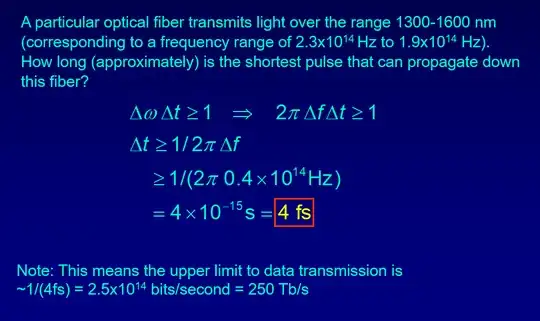While the calculations seem fine, I can't make sense of the solution to this problem. How can the uncertainty principle be used to tell us what the shortest pulse is? Wouldn't using it tell us the error in the pulse lengths? And the pulse lengths then could be arguable any size we want it to be.
3 Answers
This is categorically NOT the Heisenberg uncertainty principle itself.
However, it is the mathematical property of the Fourier transform that gives rise to the Heisenberg uncertainty principle. The coarsest property about the Fourier transform along these lines is that a function and its FT cannot both have compact support: that is, if a function is nonzero only on a finite interval, the Fourier transform must be nonzero over an infinite range of frequencies and contrariwise.
A more quantitative version is that the root mean square spread of a function $f(x)$ and the root mean square spread of its Fourier transform $F(k)$ always multiply to a number that is greater than a half:
$$\sqrt{\frac{\int_{-\infty}^\infty (x-\bar{x})^2\,|f(x)|^2\,\mathrm{d}\,x}{\int_{-\infty}^\infty |f(x)|^2\,\mathrm{d}\,x}}\;\sqrt{\frac{\int_{-\infty}^\infty (k-\bar{k})^2\,|F(k)|^2\,\mathrm{d}\,k}{\int_{-\infty}^\infty |F(k)|^2\,\mathrm{d}\,k}} \geq \frac{1}{2}\qquad(1)$$
where:
$$\bar{x} = \frac{\int_{-\infty}^\infty\,x\,f(x)\,\mathrm{d}x}{\int_{-\infty}^\infty\,f(x)\,\mathrm{d}x}$$ $$\bar{k} = \frac{\int_{-\infty}^\infty\,k\,F(x)\,\mathrm{d}k}{\int_{-\infty}^\infty\,F(k)\,\mathrm{d}k}$$
are the means values of $x$ and $k$ and this is what you should use. Equality rather than $>$ happens if and only if $f(x)$ is a Gaussian, as I show in more detail in this answer here. Often you will see the result above stated for zero mean functions.
The Heisenberg uncertainty principle arises in quantum mechanics because the canonical commutation relationship implies that position and momentum co-ordinates are related to each other by a Fourier transform. So the spreads of the quantum state when expressed in these two different co-ordinates are related by (1), modulo some scaling constants.
There is sometimes said to be a "Heisenberg inequality" for time and energy, but this is a subtly different thing again. User JoshPhysics discusses this in detail in his answer here.
- 90,184
- 7
- 198
- 428
The pulse length is the error in the pulse length; these are the same thing and that's why they cannot be different the way you want them to be.
In other words, you are not dealing with random signals here, but rather this is a property of any signal $f(t)$. Such a signal can be normalized in a few ways, but the easiest is to pretend that $|f(t)|^2$ is a probability density function so that we can define a ”mean” and "standard deviation". But this analogy is just an analogy we use to borrow words: it does not mean what random variables usually mean. (The latter would be: “The entire signal is concentrated at exactly one instant but we do not know which instant, but we can tell you the average time that this instant clusters around and the standard uncertainty you'll face if you pretend it is at that instant.”)
It may help to see this analogy used somewhere else: “center of mass” is really an average position vector, where the mass density is being normalized to a sort of probability density function on $\mathbb R^3$. One could similarly define a “characteristic size” as the standard deviation. Similarly we are using the “standard deviation” $\Delta t$ to understand the characteristic time of the pulse, but this does not make it into a random variable with error bars by magic--it is an analogy and in this analogy the standard error just is a definition of the pulse duration.
- 39,588
The problem and solution you show is a purely classical one. No need to invoke anything quantum related.
Just consider a classical superposition of sine waves each at a slightly different frequency and with a fixed phase relationship (just equate this fixed phase value to zero for simplicity). They what you'll find is that as you add more and more frequencies, the time domain waveform will become a pulse of shorter and shorter duration. So, ultimately the more frequencies you have (delta f) the shorter the duration of pulse is (delta t).
Try this on your computer to illustrate the point: Plot: Sin(t) + Sin(2t) + Sin(3t)+ ..... Keep adding terms and watch what happens to the superposition.
